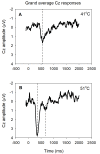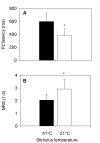"First pain" in humans: convergent and specific forebrain responses
- PMID: 21083897
- PMCID: PMC3000383
- DOI: 10.1186/1744-8069-6-81
"First pain" in humans: convergent and specific forebrain responses
Abstract
Background: Brief heat stimuli that excite nociceptors innervated by finely myelinated (Aδ) fibers evoke an initial, sharp, well-localized pain ("first pain") that is distinguishable from the delayed, less intense, more prolonged dull pain attributed to nociceptors innervated by unmyelinated (C) fibers ("second pain"). In the present study, we address the question of whether a brief, noxious heat stimulus that excites cutaneous Aδ fibers activates a distinct set of forebrain structures preferentially in addition to those with similar responses to converging input from C fibers. Heat stimuli at two temperatures were applied to the dorsum of the left hand of healthy volunteers in a functional brain imaging (fMRI) paradigm and responses analyzed in a set of volumes of interest (VOI).
Results: Brief 41°C stimuli were painless and evoked only C fiber responses, but 51°C stimuli were at pain threshold and preferentially evoked Aδ fiber responses. Most VOI responded to both intensities of stimulation. However, within volumes of interest, a contrast analysis and comparison of BOLD response latencies showed that the bilateral anterior insulae, the contralateral hippocampus, and the ipsilateral posterior insula were preferentially activated by painful heat stimulation that excited Aδ fibers.
Conclusions: These findings show that two sets of forebrain structures mediate the initial sharp pain evoked by brief cutaneous heat stimulation: those responding preferentially to the brief stimulation of Aδ heat nociceptors and those with similar responses to converging inputs from the painless stimulation of C fibers. Our results suggest a unique and specific physiological basis, at the forebrain level, for the "first pain" sensation that has long been attributed to Aδ fiber stimulation and support the concept that both specific and convergent mechanisms act concurrently to mediate pain.
Figures





Similar articles
-
An inhibitory interaction of human cortical responses to stimuli preferentially exciting Adelta or C fibers.Neuroscience. 2008 Mar 27;152(3):798-808. doi: 10.1016/j.neuroscience.2007.11.050. Epub 2007 Dec 8. Neuroscience. 2008. PMID: 18308475 Free PMC article.
-
The fine tuning of pain thresholds: a sophisticated double alarm system.PLoS One. 2010 Apr 23;5(4):e10269. doi: 10.1371/journal.pone.0010269. PLoS One. 2010. PMID: 20428245 Free PMC article.
-
Human brain responses to concomitant stimulation of Aδ and C nociceptors.J Neurosci. 2014 Aug 20;34(34):11439-51. doi: 10.1523/JNEUROSCI.1355-14.2014. J Neurosci. 2014. PMID: 25143623 Free PMC article.
-
Role of Mechanoinsensitive Nociceptors in Painful Diabetic Peripheral Neuropathy.Curr Diabetes Rev. 2022;18(5):e081221198649. doi: 10.2174/1573399818666211208101555. Curr Diabetes Rev. 2022. PMID: 34879806 Review.
-
Inescapable and escapable pain is represented in distinct hypothalamic-midbrain circuits: specific roles for Adelta- and C-nociceptors.Exp Physiol. 2002 Mar;87(2):281-6. doi: 10.1113/eph8702356. Exp Physiol. 2002. PMID: 11856975 Review.
Cited by
-
Offset analgesia is reduced in older adults.Pain. 2013 Nov;154(11):2381-2387. doi: 10.1016/j.pain.2013.07.015. Epub 2013 Jul 16. Pain. 2013. PMID: 23872117 Free PMC article.
-
Equal pain-Unequal fear response: enhanced susceptibility of tooth pain to fear conditioning.Front Hum Neurosci. 2014 Jul 18;8:526. doi: 10.3389/fnhum.2014.00526. eCollection 2014. Front Hum Neurosci. 2014. PMID: 25100974 Free PMC article.
-
The Role of Stress Regulation on Neural Plasticity in Pain Chronification.Neural Plast. 2016;2016:6402942. doi: 10.1155/2016/6402942. Epub 2016 Dec 8. Neural Plast. 2016. PMID: 28053788 Free PMC article. Review.
-
The medial temporal lobe in nociception: a meta-analytic and functional connectivity study.Pain. 2019 Jun;160(6):1245-1260. doi: 10.1097/j.pain.0000000000001519. Pain. 2019. PMID: 30747905 Free PMC article.
References
-
- Price DD. Psychological mechanisms of pain and analgesia. Seattle: IASP Press; 1999.
-
- Bishop GH. The relation between nerve fiber size and sensory modality: phylogenetic implications of the afferent innervation of cortex. J Nerv & Mental Dis. 1959;128:89–114. - PubMed
Publication types
MeSH terms
Grants and funding
LinkOut - more resources
Full Text Sources
Medical

